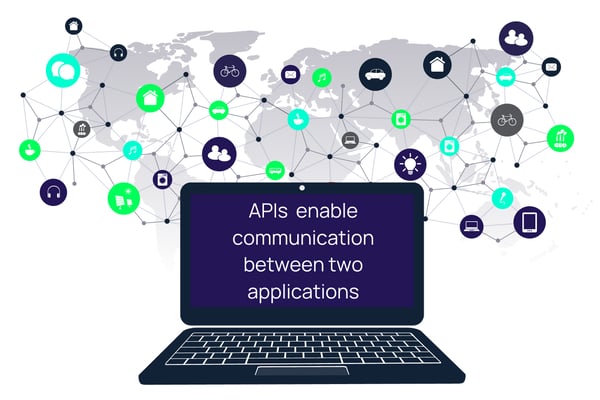Application Programming Interfaces (APIs)
What are APIs?
APIs are software intermediaries that enable communication between two applications. That is, they facilitate the exchange of data and services between different software components.
For example, the client application might request financial data from a banking institution’s software system. The bank's system, acting as the server, would then respond with the requested data. The interaction is facilitated by the API, which defines how the request for financial data should be made and how the response should be structured. Using this example, we can see why API security is of utmost importance.
APIs define a set of rules and protocols that dictate how these software components interact with each other, ensuring that they can communicate effectively and efficiently.
The average number of APIs in an organization grew 82% in 2022. Because they are ubiquitous, APIs are also prime targets for criminals—they underpin and pull together so many digital, back-end services. For this reason, APIs should be treated as super-users and protected with the same precautions.

Types of APIs
APIs come in various forms depending on their purpose. Knowing their purpose helps you determine the potential security risk and guides the types of API security techniques and strategies you should employ.
Here are some of the common types of APIs:
1. Web APIs
- RESTful APIs: These use HTTP methods to perform CRUD (Create, Read, Update, Delete) operations on resources. They are widely used for web services.
- SOAP APIs: These use the Simple Object Access Protocol for communication and are often used in enterprise applications.
- GraphQL APIs: GraphQL allows clients to request exactly the data they need and nothing more, reducing over-fetching or under-fetching of data.
2. Library or Framework APIs
These are APIs provided by programming libraries, frameworks, or SDKs to simplify and streamline specific development tasks. Examples include the Java Standard Library, .NET Framework, and TensorFlow for machine learning.
3. Operating System APIs
These APIs provide a set of functions and procedures that allow applications to interact with the operating system. For example, the Windows API or POSIX API for Unix-like systems.
4. Database APIs
These APIs allow applications to interact with databases. Examples include JDBC for Java, ODBC for various platforms, and the SQL API for relational databases.
5. Hardware APIs
Hardware APIs give access to hardware components like sensors, cameras, and peripherals. Examples include Android's Camera API and Windows' DirectX for graphics.
6. Cloud APIs
These APIs provide access to cloud services and resources, for instance, the AWS API for Amazon Web Services, the Google Cloud API, and the Microsoft Azure API.
7. Payment APIs
These are used in e-commerce and finance to process payments. Examples include PayPal, Stripe, and Square APIs.
8. Mapping and Geolocation APIs
Services like Google Maps and Mapbox offer APIs to embed maps and geolocation features into applications.
9. Messaging APIs
Messaging services provide APIs for integrating chat and messaging features into applications. Examples include the WhatsApp API and the Slack API.
10. IoT APIs
Internet of Things (IoT) APIs are used to connect and control IoT devices. These APIs enable communication with smart devices and sensors.
11. Data APIs
These APIs offer access to data sources such as public datasets, weather data, and financial market data.
12. Custom APIs
Organizations often create custom APIs to expose specific functionalities of their software or services for internal or external use.
How are APIs used?
APIs have a wide range of use cases across various industries and domains.
Some common scenarios where APIs are extensively used include:
- Social Media Integration: APIs provided by platforms like Facebook, Twitter, and Instagram enable developers to integrate social media features, such as sharing content or retrieving user data, into their applications.
- Payment Processing: Payment gateway APIs like PayPal and Stripe facilitate secure online payments, allowing e-commerce websites to accept payments from customers.
- Cloud Services: Cloud providers like AWS, Azure, and Google Cloud offer APIs for managing and accessing cloud resources, such as virtual machines, storage, and databases.
- Maps and Geolocation: APIs like Google Maps and Mapbox provide location-based services, enabling applications to display maps, find directions, and locate nearby points of interest.
- IoT Connectivity: IoT device manufacturers often provide APIs for developers to interact with and control IoT devices, collect sensor data, and automate actions.
- Financial Services: APIs offered by banks and financial institutions enable users to access account information, initiate transactions, and manage their finances through third-party applications.
- Weather Data: Weather APIs offer access to real-time and forecasted weather data, which can be integrated into applications for planning and decision-making.
In today’s digital world, APIs are essential for connecting and integrating disparate systems and services. Credentials and access control mechanisms play a critical role in ensuring the security and proper functioning of these APIs. At the same time, their use cases span a wide array of industries and applications.
Try Our Free IT Tools